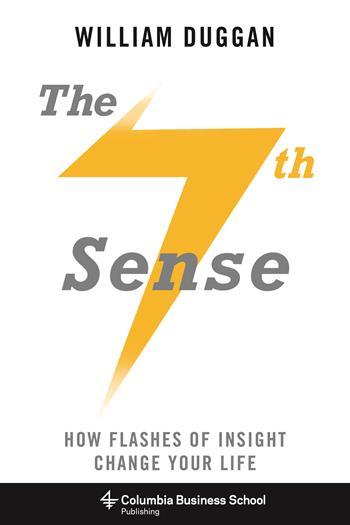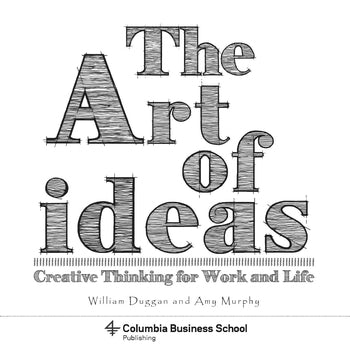Your Seventh Sense: Beyond Mindfulness
The following post is by William Duggan, author of The Seventh Sense: How Flashes of Insight Change Your Life:
You need more than meditation to calm your mind.
Over the past decade, meditation has become a popular method in the business world for promoting “mindfulness” among employees. The benefits are better health in general and a calmer mind to concentrate better at work. And a calm mind promotes creativity: that’s why you have your best ideas when your brain is relaxed, in the shower, driving, on the train or plane, at the gym, running, walking, or falling asleep at night. In a calm mind, pieces of a puzzle come together in a flash of insight, otherwise known as your “seventh sense.”
Your sixth sense is rapid recognition from experience: for example, when you hear a relative’s footsteps and know exactly who it is. Your seventh sense is slower, and draws from everything you know, not just your own experience. The calmer your mind, the better your brain can search through more and more connections until the solution comes in a flash.
Meditation makes you more “mindful.” That is, you train your mind to appreciate the present moment rather than dwell on past sorrows or future worries. There are two basic kinds of mindfulness training: samatha and vipassana, both from the Hindu tradition. Most forms of meditation today follow one or the other method, or combine them both.
Samatha is point meditation, and vipassana is mind wandering. In samatha you pick a single visual point, with your eyes or in your mind: when your mind strays to other thoughts, you bring it back to that single point. In vipassana you let your thoughts go where they may, pay attention to each thought in turn, let it go, and let the next thought come in.
Most neuroscience research on meditation is about vipassana, which is harder to do than samatha. Some experts consider samatha a form of training for vipassana. Samatha keeps bad thoughts away. Vipassana lets bad thoughts come in and then go out. You can see how vipassana is better for dealing with the flow of bad thoughts from stress: instead of building a dam against them (samatha), you let them flow by (vipassana).
But what if the bad thoughts just keep returning? And it’s often the same thoughts, again and again, like one of those self-filling fountains, where the water drains down, back up a pipe and into the fountain again. You meditate, and then five minutes later the same bad thoughts come back.
What then?
As it turns out, a second method from the Zen tradition helps you not just dam up your bad thoughts, or let them flow by, but actually turn them off. Here we call it Free Your Mind.
First let’s see why bad thoughts are bad for you. A negative thought creates a negative emotion: that causes mental pain and releases the hormone cortisol into your brain. Cortisol is bad, for two reasons. First, it reduces your immunity to all diseases. Second, it blocks memory, which is the basis of all thoughts, especially creative ones. Mental pain is also physically draining, just like bodily pain, and can make it hard to sleep. In total, negative emotions are bad for you in six ways: they cause mental pain, drain you physically, weaken your immune system, keep you awake, block your creative thoughts, and make you unhappy.
Reducing negative emotions is actually one of the toughest mental tasks that humans face. Meditation is a temporary fix—afterward, back in your normal life, the negative emotions return. Science shows that there is some halo effect: the more you meditate, the lower your cortisol overall. But even so, negative emotions will still cause your cortisol to rise.
One way to reduce negative emotions is to reduce the negative thoughts that lead to them. The “positive psychology” movement tells you to think positive thoughts, not negative ones. And most forms of “cognitive behavioral therapy” tell you that your negative thoughts are irrational, so think them through rationally and they go away. Unfortunately, these are false cures in many cases. They can only work for so long. Eventually reality breaks through. Some of your negative thoughts might be easily swapped for positive ones, or might in fact be irrational. But the negative thoughts that bother you most are different: they’re true. You can’t just paste a smiley face over them or pretend they’re irrational.
Many negative thoughts are an accurate assessment of a situation you face. If you try to be positive about a true negative thought, or tell yourself it’s irrational, your seventh sense kicks in. A doubt starts in the back of your mind, then nags away until it can finally get your attention. The more you try to ignore it or worse, pretend it’s not true, the longer it takes to see it. Your ‘creative thought’ is actually an insight that something is wrong: for example, your boss really does hate you. No positive thinking or rational analysis will make that truth go away.
In this way, many negative thoughts are good because they are true. Mental pain is like physical pain: a signal from your body that tells you something is wrong. You should not ignore physical pain, or tell yourself it’s irrational to feel it. Instead, you try to do something about the cause of the pain. It’s the same with mental pain: Free Your Mind is a way to do something about the cause of your mental pain.
Here’s how.
First you must recognize that all negative emotions have the same cause: not getting what you want. It’s either a “past sorrow,” that is, something you didn’t want that already happened — or a ‘future worry,’ that is, something you don’t want that you think will happen. There is no “present”—the previous millisecond is already the past and the next millisecond is the future.
So your next step is to identify whether your negative emotion is a past sorrow or a future worry. Then you break that down into two parts: what is within your control, and what is outside your control. In the Zen tradition, these are dharma and karma. Your third step is to think through all the actions you might take as dharma. Your fourth step is to accept the fact that there is nothing you can do about the karma.
In this way, “good” thoughts are different from “happy” thoughts. When you discuss a problem with someone, and you say something realistic and useful, the other person might reply, “Good thought.” This kind of good thought is different from a happy thought, which is “good” only in the sense that it gives you pleasure and therefore does not harm the brain the way negative emotions do. Some happy thoughts are realistic and useful, but some are fantasy or wishful thinking. A happy thought that leads you astray is a bad thought.
Likewise, good thoughts are not always positive. You might say, “I think this means we’re about to be fired,” and the other person might say, “Good thought.” That is, your negative assessment of the situation is realistic and useful: you can start planning what to do next. But the thought is only ‘good’ if it comes without negative emotion. If your thought is realistic and useful but causes you mental pain, it is not a good thought.
We are only human, so “we’re about to be fired” usually triggers a negative emotion. But the discipline of Free Your Mind helps you respond right away — in the next moment if you can — with a search for what action to take. What is your frustrated desire, exactly: that is, what do you want that you think you can’t get? Then think through your karma and dharma: circumstances beyond your control and what you can do in the face of them.
Free Your Mind turns stress into strategy. Your negative emotions become strategic thinking. Cortisol drains from your brain. As with any discipline, you can get better at it over time. The first time you try, it might take you days to feel better. Eventually, just one day. Then half a day. And so on. The aim is to make it automatic, so whenever you feel a negative emotion, your brain kicks in with these four steps.
Dharma is harder than karma to figure out. Often you don’t know whether there is something you can do or not, but you have the nagging feeling that there might be. It’s a common reason for tossing and turning at night. If you cannot find any course of action to try, then “accept it.” That is, tell yourself you thought the whole thing through and you don’t see what you can do. It’s not easy, but with practice you get better at accepting your karma with less and less negative emotion.
But don’t “accept it” too fast. There’s one thing you can always do: search. Chances are good that someone, somewhere, at some time, faced a situation similar to yours in some way. Perhaps someone else figured out something useful to do that might apply to you too. Ask whoever you can if they know of a case like that. Search on the internet. Of course, more personal problems are harder to ask other people and harder to search about find online. But just the act of searching is a form of dharma, and reduces the cortisol in your brain.
1 Response
Leave a Reply
You must be logged in to post a comment.




I didn’t realize that the type of mindfulness meditation practice I’ve been doing is referred to as “point meditation” or “Samatha.” I’m so happy to see mindfulness practice being more widely accepted as valuable in business as well as interpersonal relationships. Thank you for this post.